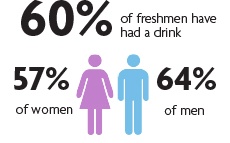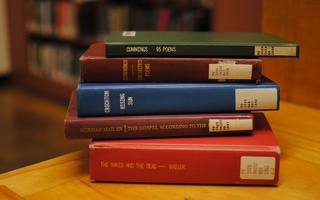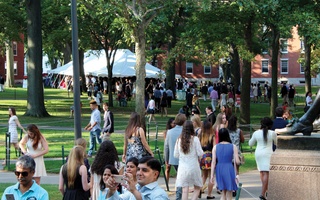{shortcode-ecd1fb5e731a80a9428b9315569d147f3f758f67}
Part I of a five-part series on Harvard’s incoming Class of 2018, based on data collected by The Crimson in an email survey conducted in the month of August. Part II will run on Wednesday.
More than a quarter of surveyed students in the Class of 2018—the most diverse in Harvard College history by some metrics—reported that a member of their immediate or extended family attended the College, according to The Harvard Crimson’s annual survey of the incoming freshman class.
Sixteen percent of respondents reported that at least one of their parents attended the College, meaning that they are considered Harvard legacies by the College. Members of this group “may receive an additional look” in the admissions process, according to the College’s website.
Dean of Admissions and Financial Aid William R. Fitzsimmons ’67 said in an interview in 2011 that approximately 12 to 13 percent of Harvard undergraduates were considered legacies. Yale College reported that 14 percent of its Class of 2017 had legacy affiliation.
Prior connections to the College were also revealed through sibling relationships, with 8 percent of students indicating that they have siblings who matriculated as Harvard undergraduates.
Freshmen who reported coming from wealthier backgrounds were more likely to say that they have a relative that attended the College. A majority of freshmen with parents that have a reported combined income greater than $500,000 said they have a relative who attended the College, and 43 percent of respondents with parents that have a combined income greater than $250,000 said the same. Only 18 percent of those with parents that earn a combined income less than $250,000 reported that a relative was at one time a Harvard undergraduate.
The email survey, conducted by The Harvard Crimson, was emailed to all incoming freshman on Aug. 6 and closed on Aug. 28. Of the 1667 students in the incoming freshman class, 1,172 responded to the survey, representing around 70 percent of the class.
Beyond questions about their family’s history at the College, this annual survey encompassed a broad range of topics, including demographics, financial and educational backgrounds, academic and extracurricular experiences, political and religious beliefs, sexuality, drug and alcohol use, mental health, and technology preferences. The Crimson did not adjust the survey results for any possible selection bias.
Breaking it Down
While the demographics of the incoming freshman class are largely consistent with those of the Class of 2017, female students make up a smaller proportion of this year’s surveyed freshmen compared to last year’s.
According to the data, 47 percent of respondents is female and 53 percent is male, compared to a roughly even split in recent years. Fitzsimmons said in March that the College admitted more males than females for the class.
Little has changed with the ethnic composition of this year’s Harvard Yard occupants. With some students identifying as multiple ethnicities, 62 percent of respondents identified as white, 24 percent identified as Asian, and 11 percent identified as black or African American. Hispanic and Latino students make up a reported 12 percent of the class. Those numbers are consistent with official statistics released by the College.
Roughly 90 percent of respondents identified as heterosexual, remaining unchanged from last year’s survey. Four percent of students responded that they are homosexual. Bisexual students and students who are “questioning” each accounted for about 3 percent of the class.
Of those who said they were homosexual, 78 percent identified as male, 17 percent identified as female, and 5 percent identified as “other.” However, females were more likely to identify as bisexual or “questioning.” Of those who identified as bisexual, 63 percent were female, while 30 percent were male. Similarly, 66 percent of those who identified as “questioning” were female and 34 percent were male.
Read more in College News
McKinlock Renovations Draw Praise from Leverett CommunityRecommended Articles
-
LettersFlawed Methodology on Living Wage Poll To the editors: According to “Weekend Survey Shows Lack of Support for Sit-In,” (News,
-
 Freshman Survey Part IV: Sex, Drugs, and MacBook Pros
Freshman Survey Part IV: Sex, Drugs, and MacBook Pros -
 Freshman Survey Part III: Inside the Classroom and Out
Freshman Survey Part III: Inside the Classroom and Out -
 Freshman Survey Part IV: Liberals, Virgins, and Facebook Fanatics
Freshman Survey Part IV: Liberals, Virgins, and Facebook Fanatics -
 Highlights from the Class of 2019 Survey
Highlights from the Class of 2019 Survey













